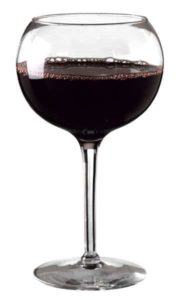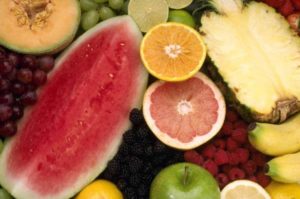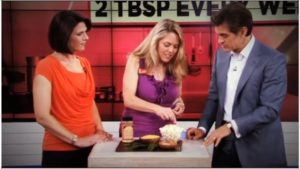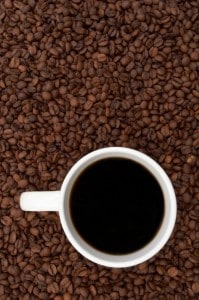This article is also available as a podcast. Click to listen:
In an effort to help people make healthier choices when eating out, many restaurants are now required to publish calorie counts and other nutrition information right on their menus. Usually, the laws only apply to restaurants with more than one location, such as fast food and chain restaurants.
Even if they aren’t required to put them on the menu, most chain restaurants and some others publish nutrition information on their websites.
Many Would Rather Not Know
I’ve heard from a lot of people who say that having nutrition information on the menus takes some of the fun out of eating out. And frankly, the restaurants aren’t that crazy about the idea either because they know that many restaurant goers would be horrified to find out just how many calories their favorite dishes contain.
Having spent some time in professional kitchens I can tell you that sparing calories is not the first priority of most chefs. They want their food to taste good and it’s a whole lot easier to turn out tasty dishes when no one’s measuring out the butter, if you know what I mean.
Sidestepping the issue of whether it’s fair (or even constitutional) to force restaurants to put calorie counts on the menus, I have to say that, from a public health perspective, it has brought about some positive changes. Being forced to disclose the calorie counts on menus has motivated many chains to add healthier, lower-calorie choices to their menus.
And, even if people say they would rather not know how many calories are in that plate of fettuccini Alfredo or that side of onion rings, having the number right there on the menu makes it a bit harder to remain in denial—and often results in people making healthier choices.
Take Menu Information with a Grain of Salt
Now, I have to warn you to take the nutrition information you see on menus with a grain of salt. When preparing a sample dish for analysis, ingredients are precisely measured. But dishes are not going to be as carefully executed in the heat of battle as they were for nutrition analysis. Unless it’s a highly automated fast-food restaurant where every squirt of special sauce is premeasured, you’re likely to get portions that are significantly larger, cooked in more oil or butter, and served with more salt, sauce, or salad dressing than the version that was analyzed.
Whether or not nutrition information is provided on the menu, and regardless of how reliable it may be, it is possible to find the healthier dishes by reading menu descriptions carefully and learning to watch for certain code words.
The words “creamy,” “crispy,” and “smothered,” for example, are all code for “slathered in fat.” I’d also be on guard against items described as “rich,” “thick,” or anything topped with several kinds of cheese. Instead of dishes that get their flavor from heavy sauces, look for the simpler preparations. Words like “steamed,” “seared,” “poached,” or “grilled” signal a lighter, leaner style of cooking.
Ordering Strategies
In addition, there are a couple of ordering strategies that can help you get a healthier meal without feeling like you’re left nibbling nothing but garnishes.
- Request that salads and other dishes be lightly dressed or sauced. Sauces and dressings are where all the calories hang out and most kitchens apply them with a heavy hand. Asking for things to be lightly sauced or dressed usually results in a lower-calorie plate, not to mention a better-balanced and tastier dish.
- Inquire about half portions. Except for those frou-frou nouvelle cuisine restaurants where everything is the size of an ice cube, most restaurant portions are two or three times what any normal person should be eating at a meal. Even if they are not listed on the menu, many kitchens will serve half-portions upon request.
- Ask for the veggie of the day. Although they may not be listed on the menu, most restaurants will have one or two fresh vegetables that they are serving on any given day. These can often be requested in place of potato or French fries.
Finally, you’ll have an easier time finding healthy menu options if you pick your restaurant carefully. As much as I love Indian food, most Indian restaurant meals are very high in fat and calories, for example. Sushi restaurants, on the other hand, are a great place to get a light, nutritious meal. Pub grub is usually heavy on fried foods, whereas a grill will have more healthy choices. Diners tend to specialize in things covered with cheese, gravy, or syrup; a bistro usually has entrée salads and other lighter options.
You can also take advantage of the “small plate” trend by seeking out Spanish or Middle Eastern restaurants that serve tapas or mezze. Instead of ordering an entrée, you make a meal out of small “tasting” portions of three or four different dishes. You can turn any restaurant into a small plate restaurant, by the way, by ordering two or three appetizers as your meal. Just remember, when selecting appetizers and small plates, to apply all of the guidelines we just talked about. Avoid the crispy chicken smothered with three cheeses, and go for the grilled shrimp on a bed of spinach!
Originally published at QuickandDirtyTips.com
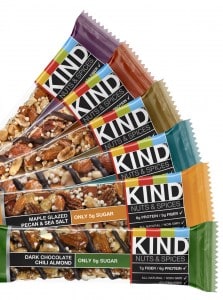 My primary complaint with most granola and snack bars is that they’re all so high in sugar (or, in the case of the low carb bars, high in fake sugar). It’s not merely a nutritional objection; I find most of them unpleasantly sweet. So I was intrigued to learn about a new line of bars and granola from KIND, each with 5 grams of sugar or less–no artificial sweeteners or sugar alcohols.
My primary complaint with most granola and snack bars is that they’re all so high in sugar (or, in the case of the low carb bars, high in fake sugar). It’s not merely a nutritional objection; I find most of them unpleasantly sweet. So I was intrigued to learn about a new line of bars and granola from KIND, each with 5 grams of sugar or less–no artificial sweeteners or sugar alcohols.

